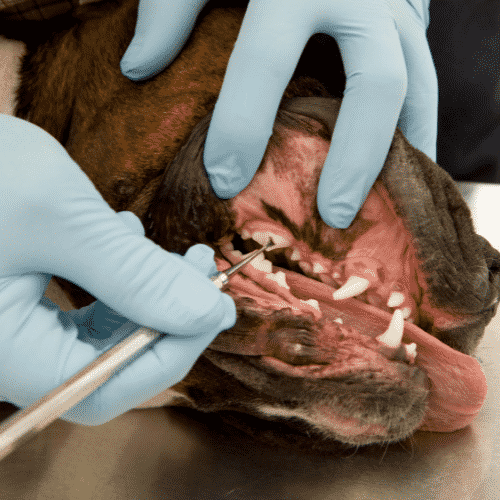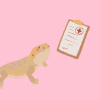Your veterinarian may have informed you that your dog requires a teeth cleaning, but you may be anxious about putting your dog under anesthesia. The good news is that veterinarians take various precautions to minimize side effects during tooth cleaning in dogs. Here are all those side effects that your pet dog face after teeth cleaning anesthesia.

Low blood pressure, reduced body temperatures, vomiting, anesthesia reactions, coma, nausea, loss of hearing, etc., are all possible side effects of dog teeth cleaning under anesthesia. Although these adverse effects are rare, they can occur in some dogs.
What Actually Is Dog Anesthesia?
Anesthesia is a Greek term that means “lack/loss of sensation.” It is possible to achieve anesthesia by administering medicines that inhibit nerve activity. The purpose of anesthesia (general) is to render the patient asleep for the duration of the procedure. There is a significantly decreased ability to feel pain and relaxation of the muscles during this.
Other forms of anesthesia are local anesthesia, which involves numbing a specific region of the skin or a tooth, and spinal anesthesia, which involves administering an epidural block, a technique typically utilized in humans during childbirth.
Dog Panting & Restless? Understanding Hypervigilance In Dogs
Why Are Dental Cleanings Important in Dogs?
Even while it is feasible for a dog’s owner to attempt to clean their dog’s teeth regularly, your canine companion may not always be particularly cooperative. Instructions such as “sit,” “lie down,” and “keep your mouth open” are difficult for dogs to comprehend completely.

When your dog goes to the vet for professional dental cleaning, he or she will always be given anesthesia initially. This will minimize the stress that the procedure may provide your pet, but the anesthesia is largely needed to make the procedure easier for your beloved dog.
Side Effects of Dog Teeth Cleaning Anesthesia
Let’s discuss all the dog teeth cleaning anesthesia side effects in detail.
- Reduced Body Temperature
It is possible for older dogs to feel ill after receiving anesthesia; therefore, extra care must be taken to keep them at their optimal body temperature.
Furthermore, lower temperatures under anesthesia increase the recovery time. So, the canine patient can be kept dry by the veterinarian by using some heating equipment and warm-up liquids. Younger pups are more likely to have symptoms of chilling than older canines.
- Low Blood Pressure (Hypotension)
Low blood pressure (LBP), or hypotension in medical terms, is one of the topmost serious anesthesia-related complications affecting even healthy dogs. An adverse reaction to anesthetic medicines can cause hypotension, bleeding, tiredness, excessive anesthetic dose, and underlying cardiac issues, which are frequently present in older dogs. An urgent therapy is required for hypotension, which may involve reducing the anesthetic given and administering fluids intravenously.
- Loss of Hearing
After having his teeth cleaned, a dog could act sleepy and disobey your directions for a few minutes/hours due to the anesthesia’s effects. You have a responsibility to look after your furry pal during that time since it may fall and get an injury (such as a cut to the head, a cut to the nose, etc.).
- Anesthesia Reactions
Although this is not a very regular event, it is essential to note it. As with any other medication, there is a chance that a puppy can experience an allergic reaction to the anesthetic.
- Coma
Coma is characterized as a protracted condition of unconsciousness in which the individual remains alive but is incapable of perception. Large dosages of sedative gases or anesthetic drugs given intravenously have the potential to cause harm to the reticular activating system (RAC), which is located in the dog’s brain and is responsible for controlling consciousness.
This is a sporadic adverse reaction in dogs after receiving general anesthesia. However, this complication arises due to exceptionally high dosages of the anesthetic medications (drugs).
- Vomiting & Nausea
If a dog vomits following a dental cleaning, you should visit a veterinarian immediately, as it might indicate a deadly condition. A dog’s stomach needs to be empty before dental work requires anesthesia. If a dog has food in its stomach and then throws up after having dental work done, there is a significant risk of aspiration. This means that food could enter the lungs and induce aspiration pneumonia as well as other complications.
Do Dogs Need Anesthesia for Dental Work?
Anesthesia is not required for all canine dental cleanings; however, your vet can use anesthesia for major dental surgeries or implants. It is strongly suggested to ensure that your veterinarian can provide your dog with a comprehensive and successful treatment during any significant operation. Professional cleanings need scaling both above and below the gum line. Dental scaling performed without anesthetic does not proceed below the gum line, resulting in a mainly aesthetic procedure and provides no health benefits to the dog.
Why Does My Cat Get Along With Dogs and Other Animals But Not Another Cat?
What Factors Affect the Risks of Anesthesia in the Case of Dogs?
Due to their breed, size, condition, or age, certain dogs pose a greater anesthetic risk. These dangers can range from minimal issues, such as moderate vomiting after recovering from anesthesia, to severe problems, such as cardiac arrest or stroke, both of which can be fatal.
- Breed: Some canine breeds are more likely to experience adverse reactions to the anesthetic. Brachycephalic species, including the French Bulldog and the Boston Terrier, have higher complications associated with their airways. So, there are more adverse anesthetic effects in these dogs.
- Size: Toy breeds are at an elevated risk for anesthetic complications because of their size. This is because they are more likely to suffer from hypothermia, they may be more challenging to anesthetize and monitor, and they are more likely to overdose.
- Age: Due to changes in the immaturity of specific organs or systems, senior and very young dogs may be at a greater risk under anesthesia.

Veterinarian (DVM, MS) Content Writer, Blogger, and WordPress Developer. Working as a pet/animal/bird/fish/reptile/wildlife writer for the past 7 years on many renowned platforms.





